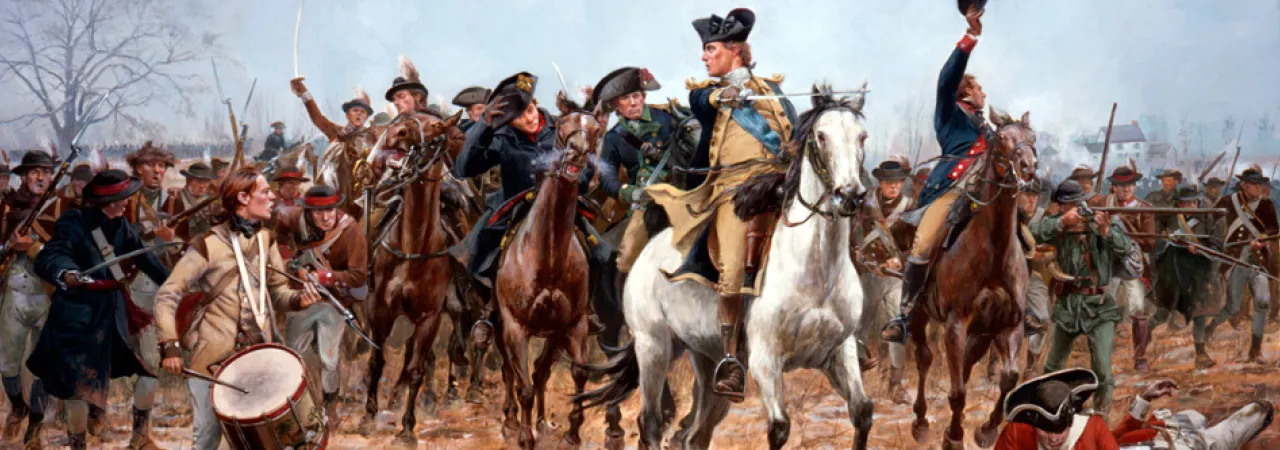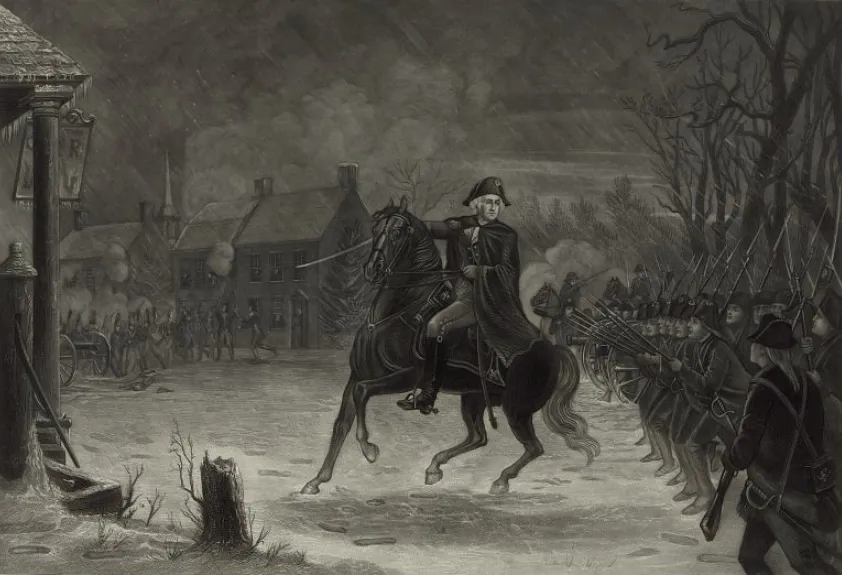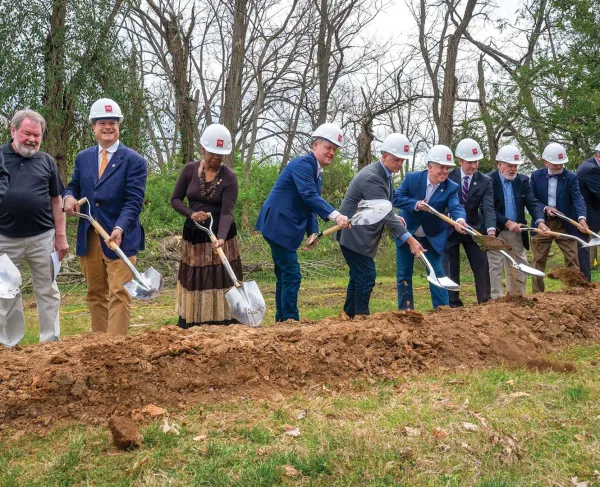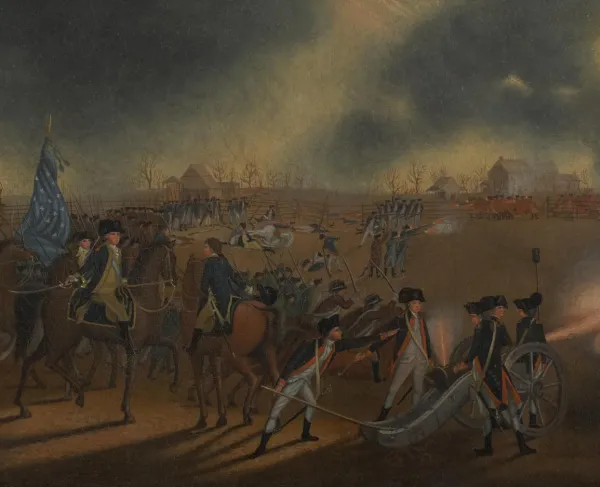
The Battle of Princeton was a quick and decisive action, fought on the cold morning of January 3, 1777, that reversed a series of British successes and revived a dying revolutionary cause. Check out these facts to expand your appreciation of this watershed battle in New Jersey.
Fact 1: The Battle of Princeton is the climax of a period known as the “10 Crucial Days.”
From the moment the first British soldier set foot on Staten Island in July 1776, the Anglo-Hessian forces under the command of General William Howe appeared unstoppable. In the weeks that followed, 400 warships and transports brought more than 30,000 soldiers from Canada, England and South Carolina to New York, intent on stopping the rebellion. These forces captured Brooklyn and Manhattan, driving General George Washington and his shrinking Continental Army across New Jersey into Pennsylvania. By winter, the revolution was dying.
The shocking Continental victory at Trenton on December 26, 1776, marked a reversal of fortunes for the Americans. In the 10 days following the crossing of the Delaware, known popularly today as the “10 crucial days,” Washington captured nearly 900 Hessian soldiers, kept the Continental Army intact, and led it to safety in the hills of northern New Jersey.

Fact 2: Four days before the battle, the Continental Army almost ceased to exist.
Washington began the summer of 1776 with 24,000 soldiers, preparing to meet the British in New York. By Christmas, the General had only 6,500 effectives, a skeleton of his former army. Congress had opted to bind soldiers to one year of service, rather than establish a standing army that they thought violated their republican ideals. For many of the men remaining under Washington’s command, these terms were set to expire on December 31, 1776. General Washington begged his men to reenlist, explaining,“[i]f you will consent to stay one month longer, you will render that service to the cause of liberty and to your country which you probably can never do under any other circumstances.” Approximately 3,300 men chose to remain, for an additional $10.
Fact 3: Information obtained by a “very intelligent young gentleman” held overnight by the British was vital to American plans to advance on Princeton.
This unidentified informant was most likely a student of Princeton University (founded in 1746 as the College of New Jersey), detained the night of December 29-30 by British troops quartered in Princeton. He “made his escape” and by noon on the 30th, reached the camp of Colonel John Cadwalader, in command of a brigade of Philadelphia Associators stationed at Crosswicks, 15 miles south of Princeton. Reporting “from the best information he could get, there were about 5,000 men, consisting of Hessians & British Troops – about the same number of each.” Gleaning every useable bit of information he could, Cadwalader drew a map of Princeton, its approaches, and the British dispositions in the area. It was in Washington’s hands the next day.
The British stationed artillery in the main street guarding the roads from Kingston to the north, Pennington from the west, and Trenton to the south. However, the informant observed that there were “no sentries on the east side of town” where a winding road led “to the back part of Princeton which may be entered on this side – the country cleared chiefly for about two miles& few fences.” This confirmed information from a mounted scouting party led by Colonel Joseph Reed the day before. This road, known as the Saw Mill Road, became Washington’s principal route to Princeton.
Fact 4: The Battle of Princeton was the second battle in two days fought by soldiers with little food or sleep.
Determined to capitalize on the momentum and renewed spirit won at Trenton, Washington returned to New Jersey, planning to “either oblige [the British] to quit their post at Princeton or risk the loss of Brunswick and the communications with New York.” After the Trenton raid, Princeton became a major forward base of operations for the British Army, drawing many troops in from the main supply depot at New Brunswick. New Brunswick also held the American General Charles Lee, captured by the British on December 12.
Taking command at Princeton, Lieutenant General Charles Lord Cornwallis aimed to draw the Americans into a general engagement and crush them. On January 2, 1777, Cornwallis advanced upon Trenton with over 8,000 men, engaging American skirmishers along the way. Once there, (in an action similar to one taken by General Ambrose Burnside at Antietam Creek 85 years later), British and Hessian troops attempted to force a crossing over a stone bridge spanning Assunpink Creek. Washington’s army stopped the advance, inflicting heavy casualties from the heights above the southern bank of the creek. Darkness ended the day’s action, leaving Washington trapped, with the Delaware River on his left and a reinforced enemy of 9,500 men in front, ready to strike in the morning.
Fact 5: Weather once again came to the rescue of the Continental Army.
The year 1777 opened with mild temperatures, which turned the frozen roads around Trenton into muddy quagmires. The conditions were so bad that the head of the British Army covered just over one mile per hour on its advance into Trenton on January 2nd.
As the evening wore on and the fighting at Assunpink Creek ended, the temperatures began to drop and the night became “exceedingly dark.” At a council of war, Washington, hoping to avoid “the appearance of a retreat” agreed with his officers that a strike on Princeton would extract the army from its tenuous position. The change in temperature proved fortuitous: it froze the sloppy mud roads, giving the Continental Army a surface it could march on for the 12-mile trek to Princeton. With Jersey militia detailed to keep bonfires lit and entrenching parties at work, Washington once again gave the British Army the slip.
Fact 6: A single British regiment bore the brunt of repeated assaults on the William and Thomas Clarke farms.
Lt. Colonel Mawhood’s 4th Brigade left Princeton before sunrise on the morning of January 3 with orders to rendezvous with the rest of the army under Cornwallis at Trenton. At dawn, a mile and a half outside of Princeton, Mawhood spotted the American columns coming down the Saw Mill Road, and turned the 4th Brigade back toward the town. He ordered his own regiment, the 17th Regiment of Foot, to cover the column. Dropping their knapsacks, the men posted along a fence in an orchard belonging to William Clarke.
In a see-sawing action across the William and Thomas Clarke farms, 246 men of the 17th, along with about 100 men of the 16th Light Dragoons, received, repulsed, and were finally overwhelmed by nearly 2,000 American troops from Mercer’s, Cadwalader’s, and Hitchcock’s brigades, aided by Edward Hand’s riflemen. The 17th paid dearly for their stand. According to Ensign George Inman, the regiment left 101 soldiers killed or wounded on the snowy ground.
Fact 7: General Hugh Mercer was the highest ranking officer killed during the battle.
General Hugh Mercer led the first attack on the 17th Regiment of Foot at the William Clarke orchard. His horse was struck, knocking the general to the ground, where he was overrun. British soldiers, thinking they had unhorsed Washington, clubbed and bayoneted Mercer, demanding that he beg for quarter. The general lingered until January 12, dying at the Thomas Clarke farmhouse, within sight of where he fell.
Fact 8: The last shots of the battle were fired on the campus of what is now Princeton University.
Legend has it that Alexander Hamilton personally commanded a battery which fired on Nassau Hall, the iconic main building of Princeton University, where remnants of the 40th and 55th Regiments of Foot had sought refuge. One ball allegedly passed through a portrait of King George II as it traveled through the building.
Major James Wilkinson, an aide to General Washington, remembered the event quite differently. “[T]here was but one gun fired at the college, and this from a six pounder, by an officer who was not advised the enemy had abandoned it; the ball recoiled, and very nearly killed my horse as I was passing in rear of the building.”
Fact 9: The Battle of Princeton was the last major battle fought by the Continental army for nearly six months.
Washington wanted to continue on to New Brunswick, but “the harassed state of our own troops (many of them having had no rest for two nights and a day) and the dangers of losing the advantage we had gained by aiming at too much, induced me by the advice of my officers to relinquish the attempt. But in my judgment, six or eight hundred fresh troops upon a forced march would have destroyed all their stores and magazines, taken (as we have since learned) their military chest containing 70,000 pounds, and put an end to the war.”
Instead, Washington marched the army into winter quarters in the safety of the Watchung Mountains of New Jersey, and started rebuilding the army. While near daily skirmishes occurred between American detachments and British foraging parties, the next major action was the Battle of Short Hills on June 26, 1777.
Fact 10: The Trust has preserved more than 24 acres of hallowed ground at Princeton!
Since 2014, the Trust has preserved more than 24 acres at the Princeton battlefield. Most recently, the Institute for Advanced Study and the American Battlefield Trust closed on the Trust’s $4 million purchase of 14.85 acres associated with the 1777 Battle of Princeton. The land, adjacent to the current Princeton Battlefield State Park, will be preserved while enabling the Institute to complete construction of new housing for its faculty on its campus. The newly acquired land, which will eventually be conveyed to New Jersey as an addition to the existing Princeton Battlefield State Park, includes approximately two-thirds of the Maxwell’s Field property – land previously slated for faculty housing – along with an additional 1.12-acre tract north of the property that has been identified by historians as a key part of the battlefield. These 15 acres witnessed one of the most legendary moments of the American Revolution when both the Battle of Princeton and the nation’s independence hung in the balance. George Washington launched a decisive charge on this property that sent the Redcoats retreating. It was Washington’s first victory over British regulars in the field.
Related Battles
75
270





